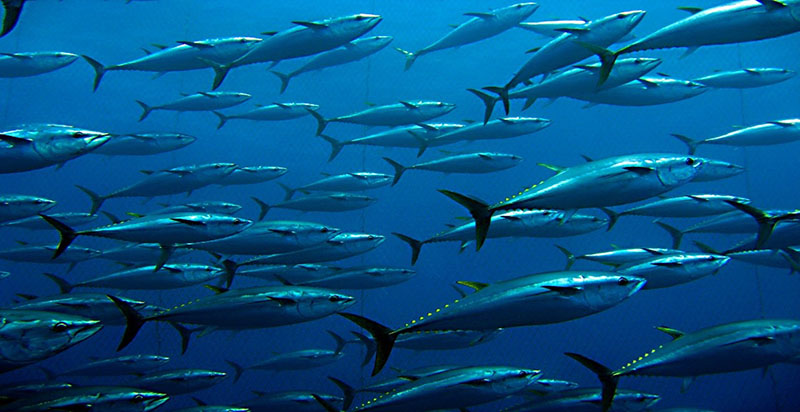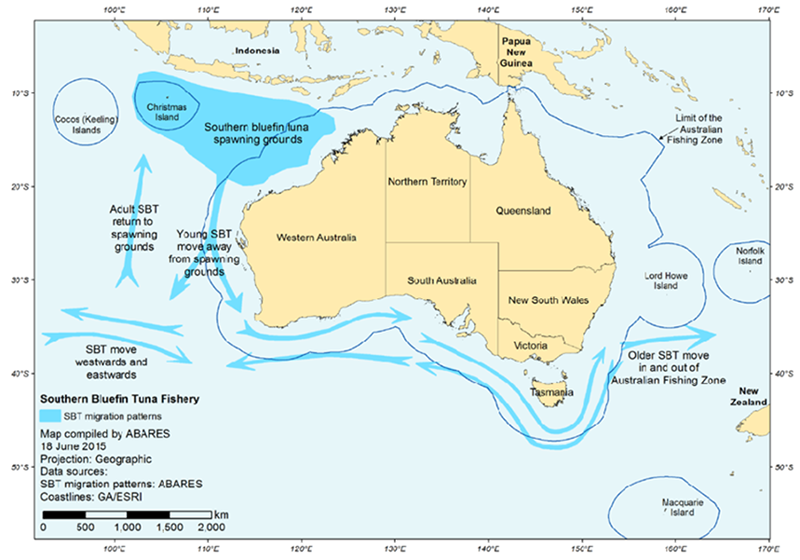The Commission for the Conservation of Southern Bluefin Tuna (CCSBT) is an intergovernmental organisation responsible for the conservation and sustainable use of the global southern bluefin tuna (SBT) stock.
The CCSBT management target is to recover SBT stock to 30% of its unfished levels by 2035.
The commission also provides guidance and updates global catch limits, usually every three years.
Southern bluefin tuna
SBT, Thunnus maccoyii, is a highly migratory pelagic species. SBT can tolerate a range of water temperatures and has a long lifespan of over 40 years. SBT is classified as conservation dependent under the Australian Environment Protection and Biodiversity Conservation Act 1999 and ongoing fishing by Australian companies is subject to strict compliance with CCSBT management measures designed to recover the stock.
Due to high demand, the species has had life-long exposure to fishing pressure, making stock slow to recover. Historically, SBT was subject to over-fishing of up to 80,000 tonnes annually.
See more about SBT.
Australian CCSBT Area of Competence
SBT range widely across the waters of the southern hemisphere. It also ranges across the exclusive economic zones and territorial seas of Australia, New Zealand, Indonesia and South Africa.
SBT has a single spawning ground in the waters south of Indonesia (northwest of Australia) between approximately 7 and 20 degrees south. The fisheries cover the entire sea area around Southern Australia including out to 200 nautical miles from the coast.
Australia’s role and highlights in CCSBT
Australia, with Japan and New Zealand founded the CCSBT in the early 1990s, and with Japan, is the largest quota holder. Australia hosts the Commission Secretariat, which is located in Canberra.
Australia contributes strongly to the scientific information used by the Commission to manage the fishery, with the CSIRO providing scientific services direct to the Commission, and also participating as part of the Australian delegation at Commission meetings.
Australia’s engagement with CCSBT is focused on rebuilding the SBT stock and worked closely with other CCSBT members to develop the CCSBT management procedure, which has seen the fishery show strong signs of recovery over the last 10 years and ensured secure access to a fair share of the global SBT quota.
Australia currently accounts for around 35% of the commercial catch of SBT globally, which generates around $140 million in exports annually for the Australian economy. See more about Australia’s fish stock status.
History and members of the CCSBT
In 1985, in response to over-fishing, Australia, Japan and New Zealand formed a voluntary management arrangement to enable more sustainable fishing measures through creating strict catch limit quotas.
In May 1994, the arrangement between Australia, New Zealand and Japan was formalised when the Convention for the Conservation of Southern Bluefin Tuna came into effect. From this the Commission for the Conservation of Southern Bluefin Tuna was created.
In 2011 the CCSBT adopted a formal rebuilding strategy to achieve SBT stock recovery goals. The rebuilding strategy (known as the management procedure) provides the CCSBT with guidance on setting global catch limits.
See more on the history of CCSBT.
The commission’s current members are:
- Australia
- New Zealand
- Japan
- The Republic of Korea
- Indonesia
- South Africa
The Fishing Entity of Taiwan and the European Union participate in the CCSBT as members of the CCSBT ‘Extended Commission’.
Commission meetings
CCSBT holds annual meetings of the Commission, the Extended Commission, Scientific Committee and Compliance Committee. Meetings are hosted by each member on a rotation basis. Several working group meetings are also held each year.
CCSBT’s headquarters are in Canberra, Australia.
More information on the CCSBT meeting schedule.
Other information


